Tiv people
Tiv (or Tiiv)[2] are a Bantoid ethnic group. They constitute approximately 3.5% of Nigeria's total population, and number about 6.5 million individuals throughout Nigeria and Cameroon. The Tiv language is spoken by about 7 million people in Nigeria with a few speakers in Cameroon. Most of the language's Nigerian speakers are found in Benue, Taraba and Nasarawa States. The language is a branch of Benue–Congo and ultimately of the Niger–Congo phylum. In precolonial times, the Fulani ethnic group referred to the Tiv as "Munchi" (also sometimes written Munshi e.g. Duggan 1932), a term not accepted by Tiv people. They depend on agricultural produce for commerce and life.
Takuruku | |
|---|---|
 | |
| Total population | |
| Approx. 6.5million[1] | |
| Regions with significant populations | |
| Languages | |
| Tiv, Tivoid languages, English, French (in Cameroon), Hausa (in Taraba, Nasarawa, Plateau, Adamawa and Kaduna States) | |
| Religion | |
| Predominantly Christian, Tiv Traditional religion, a few Muslims | |
| Related ethnic groups | |
| other Tivoid peoples and other Southern Bantoid peoples |
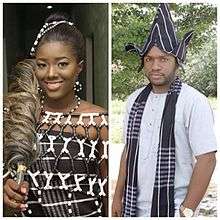

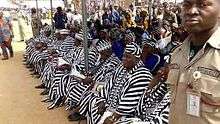
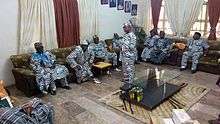
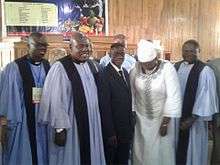
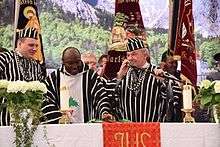




History
The Tiv say they emerged into their present location from the southeast. It is claimed >ref mark Cartwright records of the great Bantu migration that the Tiv wandered through southern, south-central and west-central Africa before arriving at the savannah lands of West African Sudan via the River Congo and Cameroon Mountains and settled at swemkaragbe the region adjoining Cameron and Nigeria in the beginning of 1500CE >ref mark Cartwright ancient history of great Bantu migration."Coming down," as they put it, was in batches, some moved southward across obudu mountains others moved northward and settled at mdema and Waka district, while others moved into Central Nigeria, this dispersions takes place in the late 1500CE to 1600CE, they mingled with the Fulani with whom they still recognize a joking relationship ("fulani Jo and Tiv Jo"). The Tiv people were a free people without a king hence every clan or kindred was administered by the eldest man called "Orya" they were amongst the first inhabitants of the Benue valley according to mark Cartwright record of Bantu migration before other tribes finally migrate to join them, Due to their peaceful disposition and disperse nature of living and no Central government nor king they pose no threat to new migrants to the region who cohabited with them until the coming of the EuropeanS The Europeans first contact with Tiv was in 1852, their late recognition was due to the lack of kingship which became a big disadvantage to Tiv in Nigeria because the colonial masters prefer working with kings, so when Tiv were found on the banks of the river benue and where known to be the major occupants of the BENUE valley, That was when kinship was later introduce to Tiv people by the European in the 1940s Benue. In 1879 their occupation of the riverbanks was about the same as in 1950. British occupying forces entered Tivland from the east in 1906, when they were called in to protect a Hausa and Jukun enclave that the Tiv had attacked. The Tiv said in 1950 that they had defeated this British force, then later invited the British in. The southern area was penetrated from the south; what southern Tiv call "the eruption" of the British there occurred in 1911.
The Tiv came into contact with European culture during the colonial period. During November 1907 to spring 1908, an expedition of the Southern Nigeria Regiment led by Lieutenant-Colonel Hugh Trenchard came into contact with the Tiv. Trenchard brought gifts for the tribal chiefs. Subsequently, roads were built and trade links established between Europeans and the Tiv.[3] But before construction of roads began, a missionary named Mary Slessor went throughout the region seeing to the people's needs.
National Attire ('Anger')
The Tiv national attire is the black-and-white-striped 'Anger'. When the Tiv people arrived at their current location several centuries earlier, they discovered that the zebra they used to hunt for meat and skin, used for ceremonial attire, was not native to the area. When they acquired the skill of the loom, they decided to honour their heritage by weaving a cloth with black-and-white stripes, reminiscent of the zebra skin; this would then be made attires as preferred. Initially, it was a simple cloth to be draped around the torso. Nowadays, it is made into elaborate robes, such as those worn by the traditional rulers and elders - from the Tor Tiv downwards.
The black-and-white colour of the necklaces worn by the traditional rulers has been chosen to match the robes.
Social and political organization
Most Tiv have a highly developed sense of genealogy, with descent being reckoned patrilineally. Ancestry is traced to an ancient individual named Tiv, who had two sons; all Tiv consider themselves a member either of Ichongo (descendants of son Chongo) or of Ipusu (descendants of son Pusu). Ichongo and Ipusu are each divided into several major branches, which in turn are divided into smaller branches. The smallest branch, or minimal lineage, is the ipaven.[4] Members of an ipaven tend to live together, the local kin-based community being called the "tar".[5] This form of social organisation, called a segmentary lineage, is seen in various parts of the world, but it is particularly well known from African societies (Middleton and Tait 1958). The Tiv are the best known example in West Africa of a society of segmentary lineage, as documented by Laura Bohannan (1952) and by Paul and Laura Bohannan (1953); in East Africa, the best known example is the Nuer, documented by E.E. Evans-Pritchard (1940).
The Tiv had no administrative divisions and no chiefs nor councils. Leadership was based on age, influence and affluence. The leaders' functions were to furnish safe conduct, arbitrate disputes within their lineages, sit on moots and lead their people in all external and internal affairs.[6]
These socio-political arrangements caused great frustration to British colonial attempts to subjugate the population and establish administration on the lower Benue. The strategy of indirect rule, which the British felt to be highly successful in controlling Hausa and Fulani populations in Northern Nigeria, was ineffective in a segmentary society like the Tiv (Dorward 1969). Colonial officers tried various approaches to administration, such as putting the Tiv under the control of the nearby Jukun, and trying to exert control through the councils of elders ("Jir Tamen"); these met with little success. The British administration in 1934 divided the Tiv into Clans, Kindreds, and Family Groups. The British appointed native heads of these divisions as well. These administrative divisions are gradually assuming a reality which they never had originally.
Members of the Tiv group are found in many areas across the globe, such as the United States and United Kingdom. In these countries, they hold unions, known as MUT (Mzough U Tiv, or Mutual Union of Tiv in English), where members can assemble and discuss issues concerning their people across the world, but especially back in Nigeria. The arm of the MUT serving the United States of America is known as MUTA (Mzough U Tiv ken Amerika, or Mutual Union of the Tiv in America), for instance.
Before the introduction of printed material, radio, film and television, mass communication in Nigeria was done through the indigenous people with the use of traditional political systems of communication. The rulers and the chiefs governed their ethnic communities and communicated with them through various channels.
Tiv music and communication
Locally made musical instruments were traditionally used for political and ceremonial communication. The key instruments follow.
Kakaki
The Kakaki is a royal trumpet used in many West African groups in Nigeria, Niger, Chad and Burkina Faso.[7] This is an instrument used to convey special messages to the people of the community, such as the birth of the child of the King, his naming ceremony, the crowning of a new king, or to gather people together during the marriage ceremony of the king and the king’s son’s marriage ceremony.[8] This instrument was used to convey all the messages to the people to assemble at the square for the ceremony. When there is an enemy attack on the community, a warning sound of the Kakaki is blown to alert those who can defend the society and every citizen to be alert.
Ilyu
A light wooden instrument, it was used to pass messages to the people of the village, probably for the invitation of the people for a particular meeting of the elders at the king’s palace or for the people to gather at the market square for a message from or by the king. Up till today, it is the main instrument for the celebration of newlyweds (marriage reception ceremony or Kwase-kuhan).
Indyer
A heavy wooden instrument carved out of mahogany trunk through some mysterious way; myth has it that a chosen carver turns into a worm to create the large hollow in the cut trunk, leaving only a small opening (like in a medical operation). This belief is perhaps due to the fact that the carvers are reluctant to explain the technique employed for such artistic finesse. The Indyer, believed to be connected with high magico-spiritual potency, is not played for secular purposes except for special occasions as sanctioned by the elders. It is used to communicate the death of an important personality in the community or to communicate a serious happening in the community, like a call to war.
Akya
It is used together with Agbande (drums) combined with Ageda at festivals to pass a message across to the people for a call for the display of culture.
Adiguve
It is an instrument like a violin, used for music and dances in conjunction with Agbande (Agbande) at festivals and dance occasions, sometimes to announce the death of a leader or an elder of the community. During this period it is played sorrowfully for the mourning of the dead. It is mostly played at funerals.
Gbande
Agbande (plural) are a set of crafted wooden musical instruments used to complement agbande at festivals. They are particularly large and are played by the young men of the community. Special drum beats communicate special messages and music for the festivals to come and during the festivals, for instance, royal occasions such as the coronation and funeral.
Ortindin (Ortyom) – Messenger
Usually, he is chosen by the elders of the community to do errands for the elders and the leader of the community. He is sent out to the heads of the neighbouring families for a crucial meeting at the head of all the leaders of the community.
Kolugh ku Bua – Cow Horn
This is an instrument made out of cow horns. There are farmers' associations that use this instrument when they have a job to do; for instance, when they are invited to make ridges on a piece of land, the Public Relations Officer (PRO) of the association will use this medium to wake up the members for the work they have for that day.
Indigenous communication is not only vertical, from the rulers to the subjects, but is also horizontal. Individuals communicate with society through physical and metaphysical means. A farm owner, for example, may mount a charm conspicuously on his farm in order to stress private ownership and to scare off human intruders.
The fear of herbalists and witches influences social behaviour considerably.
Rainmakers communicate their power to disrupt events through various psychological means. Village sectors in Africa communicate mostly via the marketplace of ideas contributed by traditional religion, observances, divination, mythology, age-grades, the Chiefs courts, the elder's square, secret and title societies, the village market square, the village drum (gbande) men, indeed the total experiences of the villager in his environment.
Unlike the mass media, access to the native media is culturally determined and not economic. Only the selected group of young men or the elders can disseminate information generally. The young only disseminate general information about events and the social welfare of their communities using the media mentioned above.
The Tiv people of Benue state still practise some of this traditional system of communication, using the Kakais, Agbande, Indyer, Adiguve, Ilyu, etc. Nevertheless the increase in the western world media is threatening the cultural communication system.
Many of the communities in Benue state still use these instruments to convey messages to the people of their community, and it is helping a great deal, since there is a language barrier between people with the introduction of the western world's means of communication, using a western language (English) to convey information.
Notable people
Politicians and activists

- Joseph Tarka, politician, human rights activist
- Barnabas Gemade, former PDP party chairman
- Aper Aku, politician
- George Akume, former senate minority leader
- Iyorchia Ayu, former senate president
- Chaha Biam, former speaker house of representative
- Gabriel Suswam, politician
- Samuel Ortom, Current State Governor
- James Ayatse, Tor-Tiv
- Daniel Saror, former minority leader
- Michael Aondoakaa, former attorney general of Nigeria
- Moses Adasu, politician
- A.I. Katsina-Alu, former chief justice of Nigeria
- Professor Iyorwuese Hagher, former Ambassador to Mexico and High Commissioner to Canada
- Colonel John Mark Inienger former Governor of Bendel state Aug 1985-Dec 1987.
*Paul Unongo, former minister for Steel Development Dec 1979-Feb 1982
Military and law enforcement
- Col. Gideon Orkar
- Gen.Victor Malu, former Chief of Army Staff
- Col.Joseph Akahan, former Chief of Army Staff
- Col. Joseph Akaagerger
- Gen.John Mark Inienger, former ECOMOG commander
- AIG Zakary Malherbe
- AIG Degar
- AIG Austin Iwar
- CP. Farida Mzamber Waziri, former EFCC Chairperson
- BrigGen.John Tom Kpera
- Michael Dyondoh
Sports icons
- Terna Suswam, football player
- Dominic Iorfa, football player
- Timothy Anjembe, football player
- David Tyavkase, football player
- Dominic Iorfa (footballer, born 1995)
- Jeff Varem, NBA D-league player
- Terna Nande, American football player
- Apollo Crews, WWE wrestler
- Francisca Ordega, Nigerian national team soccer player
- Fanendo Adi
- Barnabas Imenger Jr., Nigerian super eagles striker
See also
- Traditionalists
- "Tiv - Minority Rights Group". Minority Rights Group. Retrieved 2017-08-10.
- Duggan, E. de C. (1932) "Notes on the Munshi ("Tivi") Tribe of Northern Nigeria: Some Historical Outlines" Journal of the Royal African Society 31(123)
- Boyle, Andrew (1962). Trenchard Man of Vision. St James's Place, London: Collins. pp. 88–90.
- Asante, Molefi Kete; Mazama, Ama (2008-11-26). Encyclopedia of African Religion. SAGE Publications. p. 915. ISBN 9781506317861.
- Middleton, John; Tait, David (2013-11-05). Tribes Without Rulers: Studies in African Segmentary Systems. Routledge. p. 40. ISBN 9781136532139.
- Okehie-Offoha, Marcellina Ulunma; Sadiku, Matthew N. O. (1996). Ethnic and Cultural Diversity in Nigeria. Africa World Press. p. 105. ISBN 9780865432833.
- Lere, Ismaila (2013-07-01). "Nigeria: The Mystique of the Kakaki". Daily Trust (Abuja). Retrieved 2018-06-01.
- https://www.dailytrust.com.ng/sunday/index.php/newsroyale/13530-the-mystique-of-the-kakaki
- https://genius.com/artists/Bemshima
References
- Abraham, R.C. The Tiv People. Lagos: 1933.
- Anifowose, R. Violence and Politics in Nigeria: The Tiv and the Yoruba Experience. New York: NOK, 1982.
- Arinze, F. Africans and Christianity. Ejiofor, Rev. L. ed. Nsukka: Optimal Computer Solutions Ltd., 1990.
- Ayoade, J.A. Agbaje, A.A. eds African Traditional Political Thought and Institutions. Lagos: Centre for Black and African Arts and Civilization (CBAAC), 1989.
- Bohannan, Paul J. & Laura. The Tiv of Central Nigeria London: International African Institute, 1953.
- Bohannan, Laura (1952) "A Genealogical Charter" Africa: Journal of the International African Institute 22(4): pp. 301–315
- David, T. ed. “Political Aspects of Tiv Social Organisation” in Tribe Without Rules. London: 1958.
- Dorward, David C. (1969). "The development of the British colonial administration among the Tiv, 1900 1949". African Affairs 68:316 333.
- Downes, R.M. The Tiv Tribe. Kaduna: Government Printer, 1933.
- East, R. ed. Akiga’s Story. London: 1965.
- Ehusani, G.O. An Afro-Christian Vision “Ozovehe!.” Lanham, Maryland: University Press of America, 1991.
- Evans Pritchard, E.E. (1940). The Nuer. Oxford Univ. Press, New York.
- Gbor, Capt. J.W.T. Mdugh U Tiv Man Mnyer Ve Ken Benue. Zaria: Gaskiya Publishing Corporation, 1978.
- Hagher, I.H. The Tiv Kwagh-Hir. Ibadan: CBAAC, 1990.
- Ikenga-Metuh, E. Comparative Studies of African Traditional Religion. Onitsha: Imico Publishers, 1987.
- Ikima, O. ed. The Groundwork of Nigerian History. Ibadan: Heinemann Educational Books Nig Ltd. (for the Historical Society of Nigeria), 1980.
- Jibo, M. Tiv Politics Since 1959. Katsina-Ala: Mandate International Limited, 1993.
- Jibo, Mvendaga. Chieftaincy and Politics: The Tor Tiv in the Politics and Administration of Tivland. Frankfurt: Peter Lang AG, 2001. 325 pp. Europäische Hochschulschriften, Reihe 31: Politikwissenschaft Vol. 422
ISBN 978-3-631-36816-9 / US-ISBN 978-0-8204-4801-5 pb.
- Makar, T. A History of Political Change among the Tiv in the 19th and 20th Century. Enugu: Forth Dimension Publishing Co. Ltd., 1994.
- Makar, T. Tiv People in Power Game in Nierian Politic Circa 1950-1983. Makurdi: Government Printer.
- Mbiti, J.S. African Religious and Philosophy. London: Heinemann Press, 1970.
- Middleton, John and David Tait, editors (1958) Tribes Without Rulers: Studies in African Segmentary Systems. Routledge & Paul, London.
- Rubingh, E. Sons of Tiv. Grand Rapids: Baker House, 1969.
- Tseayo, J.I. Conflict and Incorporation in Nigeria: The Integration of the Tiv. Zaria: Gaskiya Corporation Limited, 1975.
- Vanguard Newspaper. Friday December 7, 2001.
- Vanguard Newspaper. Wednesday December 5, 2001.
- Bohannan, P. Africa. Vol. XXIV, No.1, 1954.
- Dorward, D.C. African Affairs. Vol. 68 No.273, London: 1969.
- Ewelu, I.B. West African Journal of Philosophical Studies. Vol.2, December 1999.
- Ikima, O. Journal of the Historical Society of Nigeria Vol. VII No. 1, 1973.
- http://www.everyculture.com/Africa-Middle-East/Tiv-History-and-Cultural-Relations.html#ixzz4x6ZfwkpM
Unpublished works
- Akever, E.T. The Effects of Yamishe in Tiv Traditional Marriage Culture. March 2001.
- Akpagher, T. J. Israelite Monotheism in Comparison with the Monotheism of the Tiv Traditional Religion. June 1994.
- Makar, T. A History of Political Change among the Tiv in the 19th and 20th Century. 1975.
- Ode, R. Developing Christian leadership in Contemporary Tiv Community. 1991.
- Sorkaa, A.P. The Contribution of Traditional Rulers to Rural Development in Nigeria up to the 21st Century. Paper presented at the National Conference on the Nigerian State at A.B.U. Zaria, 1987.
| Wikimedia Commons has media related to Tiv people. |
